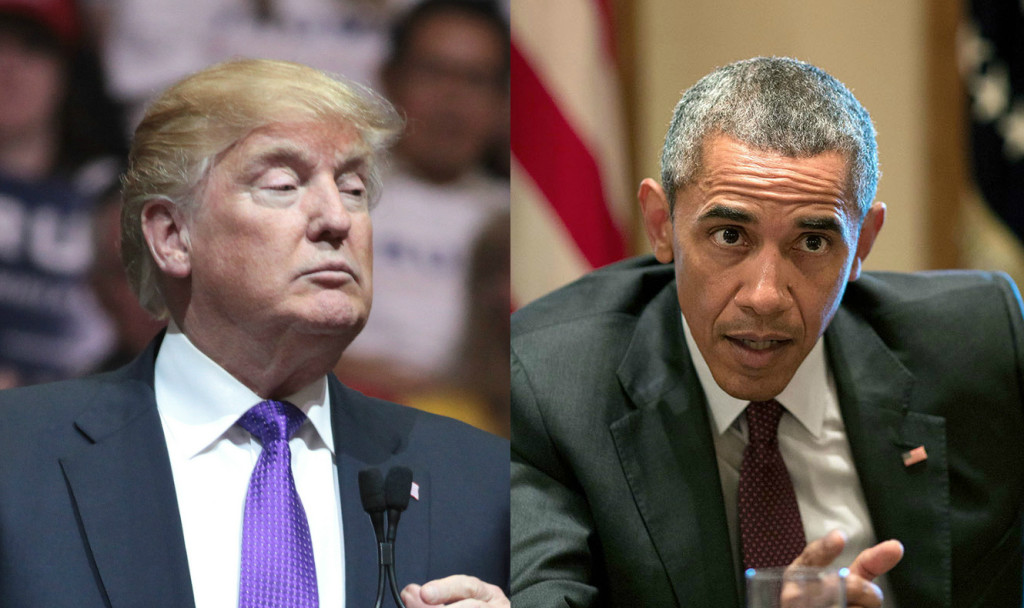What Obama and Trump Share That Divides Them From Their Parties on Foreign Policy

President Barack Obama and Donald Trump present a study in contrasts: the former a cerebral progressive, the latter a brash populist. Yet for all their differences, the similarities in the two men’s foreign policy outlooks are striking.
Two common themes emerge from Obama’s series of interviews with Atlantic journalist Jeffrey Goldberg and Trump’s recent discussions with the Washington Post and New York Times. First, both are instinctively suspicious of foreign entanglements, preferring to leave problems overseas to those states that are most directly concerned to sort out. Obama sees the United States as unable to counter Ukraine’s military domination by Russia — short at least of going to war — and ultimately powerless to counter Russian hegemony in Ukraine, reasoning that Moscow’s interest is stronger and it will thus enjoy “escalatory dominance.” Trump is even more dismissive of the United States’ role in Europe, arguing that NATO is an unnecessary expense with which Washington should dispense.
For both men, American commitments overseas detract from more pressing domestic priorities, such as infrastructure and education: “nation-building at home,” in Obama’s parlance. Trump posits a similar zero-sum relationship between spending overseas and at home: comparing supposedly fruitless U.S. efforts to build schools in Iraq with what he purports to be our inability to build a school in Brooklyn.
The second common theme emerging from the two men’s remarks is a wariness — bordering on disdain — for allies. Obama labels allies ranging from France, the United Kingdom, and Saudi Arabia as “free riders,” unwilling to contribute their fair share to solving problems such as Middle East stability. Trump meanwhile criticizes allies such as South Korea and Japan for supposedly failing to compensate the United States for our contribution to their defense, an assertion that is factually dubious but appeals to the notion that we are naively acting as the world’s policeman.
Analysts have pointed to Republican “disarray” on foreign policy, and often describe the party as split between “realist” and “neoconservative” wings. But, there is scant evidence of such a divide in reality. After eight years out of power and sobered by the lessons of the Iraq war, mainstream GOP foreign policy thought tends to be pragmatic and internationalist. Republican foreign policy analysts have more than their share of disputes — often heated — such as what to do with the Iran nuclear deal or how to approach democracy promotion — yet these tend not to reach the level of ideological or philosophical divides. Trump’s views, however — which suggest a quasi-isolationist, transactional approach to the world — diverge sharply from this orthodoxy and will perpetuate the image of GOP disarray on national security.
Yet, Obama’s views suggest that Democrats suffer from the same malady. It is striking how few Democratic foreign policy experts have defended the so-called “Obama doctrine.” Indeed, far more seem to have explicitly criticized it. And Democratic front-runner Hillary Clinton’s views are as different from Obama’s as Trump’s are from the Republican mainstream.
So does this mean that Obama and Trump share a worldview, or for that matter that Clinton and the GOP establishment do? Not quite. Both Clinton and most Republicans would argue for more, and more proactive, American leadership in the world. While disagreeing on the details, they would nonetheless argue for vigilance to deter or prevent conflict, rather than defining U.S. interests so narrowly that we are merely reactive; that allies can amplify U.S. power, reduce our burdens, and provide forward defense; and that domestic and foreign priorities are not mutually exclusive, and in fact can be mutually reinforcing. In both Syria and Ukraine, they would reject as false the choice between war with Russia and acquiescence to Moscow’s actions.
Yet where Obama and Clinton would likely agree — diverging both from Mr. Trump and his GOP rivals — is on the importance of working through international institutions. As illustrated by a 2012 survey by the LBJ School of Public Affairs at the University of Texas, Republicans are more skeptical of such institutions than Democrats. Various charges are lain at the doorstep of the United Nations and other international institutions: They dilute U.S. sovereignty and power, are wasteful and too dependent on U.S. taxpayers, are biased against the United States and Israel, and so forth. Republicans’ preference tends to be for regional or ad hoc multilateral groupings, such as the Proliferation Security Initiative organized by President George W. Bush. Trump has, in his most recent remarks, taken such sentiments to the extreme by expressing scorn not only for the United Nations, but also for NATO, and implicitly — by suggesting that other nations should consider obtaining their own nuclear weapons rather than rely on American security guarantees — the Nuclear Nonproliferation Treaty.
When viewed along these two dimensions — U.S. engagement overseas and enthusiasm for international institutions — rather than as a simple left–right spectrum, a more orderly picture of the current U.S. foreign policy landscape emerges. It is a picture which is admittedly oversimplified: It does not capture debates such as that over the appropriate U.S. strategy in the Mideast or Asia, nor does it account for officials and candidates reaching positions based on political calculation or simple post hoc rationalization. And of course, once in office presidents tend to act more pragmatically than foreshadowed by their campaign rhetoric — a pattern that will hopefully hold in the future. While admittedly simplified, this picture helps explain one of the more perplexing phenomena in politics today — the seeming foreign policy convergence between Obama and Trump, and the estrangement of each from his party’s orthodoxy.

Michael Singh is the managing director and Lane-Swig senior fellow at the Washington Institute for Near East Policy. He worked on Middle East issues at the National Security Council from 2005–2008.
Photo credit: Gage Skidmore; White House

